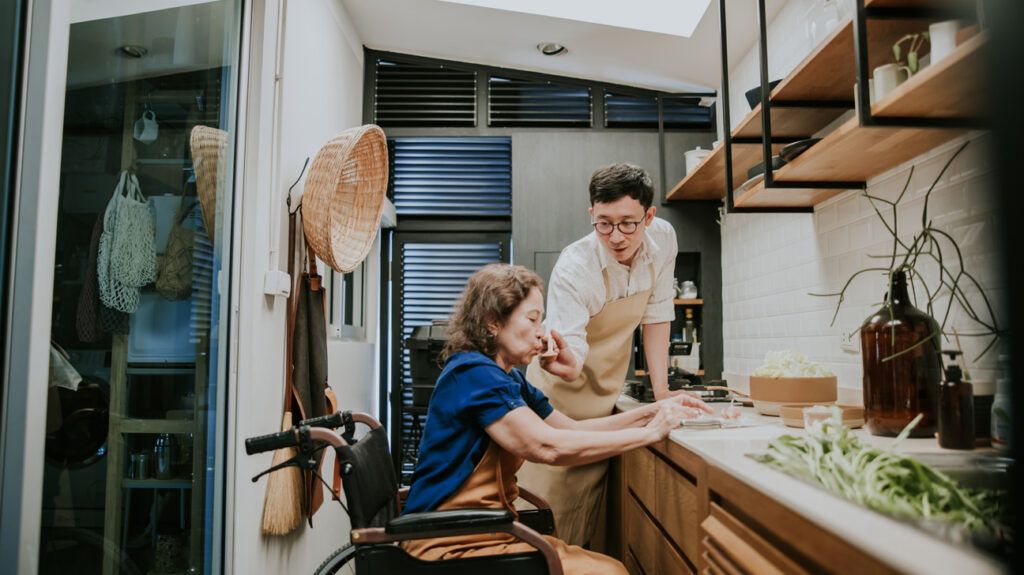Caring For Someone With Parkinson's: What To Know

A person with Parkinson’s disease (PD) may require physical, emotional, and mental support. Their needs may change from day to day.
Caring for a person living with PD may include managing medications and appointments and assisting with everyday activities, such as bathing and eating.
This article provides tips for supporting daily activities for a person with PD and tips for self-care and enjoying time together.
Caring for a person with PD can vary greatly depending on the needs of the individual. It is important to understand what support the person needs and what they can do independently.
It may take a person with PD more time to do daily activities, so they may require extra time. Symptoms can also vary, which may change what they are capable of each day or hour.
Learning about PD can help a caregiver better understand the needs of the person with PD.
Many PD organizations offer detailed information on the condition, including symptoms, treatment, and caregiving resources.
It is also helpful to learn about disease progression not only to help support a person with PD but also to better prepare for the progression of the condition.
It may help to create a daily schedule for both people to follow. Below are some tips for supporting typical daily activities.
- Use a calendar or app as a reminder for medications so both people can keep track of them.
- Use a pill box that includes each day of the week.
- Set alarms for taking medications.
- Install handrails to help a person get in and out of a bath or shower.
- Install a seat in a shower for the person to sit while bathing.
- Lower the hot water temperature to under 120°F (49°C) to prevent burns.
- Get soaps and other care products that use a pump for easier access.
- Use an electric toothbrush.
- Use an electric shaver.
- Include plenty of fiber in the diet to help prevent constipation.
- If taking levodopa, take it on an empty stomach. If this causes nausea, avoid taking it with a protein-rich meal and opt for a small protein-free snack instead.
- Prepare moist, soft foods that are easy to swallow.
- Plan smaller, more frequent meals to help manage blood pressure.
- Wear clothes that are easy to put on, such as elastic waistbands and Velcro instead of buttons.
- Choose supportive shoes with grip that are slip-on or have Velcro or elastic fastenings.
- Get a chair that offers good support for a person to sit in and dress. Get a footstool to help them put on socks and shoes.
- Devices such as long-handle shoehorns or a dressing stick may help.
- Consider relaxing activities, such as yoga, tai chi, or breathing exercises, to help manage stress, which may worsen PD symptoms.
- Make adaptations for hobbies they enjoy, such as grips for golf clubs or raised beds in a garden.
- Consider activities for creative expression, such as crafts, photography, or painting.
- Install nonslip flooring.
- Ensure all smoke alarms and carbon monoxide detectors are working properly on each floor.
- Clear clutter and any trip hazards.
- Have utensils and everyday items in easy-to-reach places.
- Have a phone within easy reach of the person, with emergency numbers programmed in.
It is a good idea to keep a calendar of appointments and accompany the person to take notes and ask any questions they may not ask.
It is also useful to understand their insurance coverage, such as what their healthcare plan includes and whether it covers prescriptions, therapies, assistive devices, and home adjustments.
Look out for subtle changes in symptoms. PD usually progresses slowly with gradual changes over time.
It may help to seek advice from a healthcare professional if caregivers are unsure how to let the person with PD know it is no longer safe to do certain activities, such as driving.
Good communication can help avoid misunderstandings or resentments. Tips for communicating with a person with PD include:
- removing distractions, such as radio or television
- avoiding making assumptions based on facial expressions, as the person may not be able to control these
- staying close and having one-to-one conversations to make it easier to hear each other
- allowing the other person time to respond
If speech becomes more difficult as PD progresses, consider contacting a speech therapist and looking for other forms of communication, such as pointing to pictures or using cue cards.
- Keep doing enjoyable activities together. Adapt any to make them easier for a person with PD.
- Find activities in which both people feel equal and able, such as socializing with loved ones or playing board games.
- Look to support groups or online forums for suggestions of activities.
- Talk with an occupational therapist who can offer ideas and support.
- Seek support from a healthcare team to spread out the care.
- Talk with others through a support group or therapist.
- Take time for self-care and relaxation.
- Keep up normal activities, such as hobbies and social groups.
When making a schedule, it is best to keep the individual’s specific needs in mind. Some people may require more day-to-day assistance than others.
Some tips to consider include:
- scheduling bathroom trips at least every 2 hours
- leaving dressing until later in the morning, as this ensures medications have started working that may help improve mobility
- scheduling activities for when a person feels their best
- balancing activities with periods of rest to help lessen fatigue
Below is an example schedule a person can modify to suit someone’s needs.
Caring for a person with PD can vary depending on their symptoms. Needs can change as the disease progresses.
Allowing the person with PD to keep their independence as much as possible is an important part of giving care. It is also critical to take time for self-care to avoid caregiver burnout.
Seeking help from a team of healthcare professionals and a support group can also help the caregiver and person with PD maintain a positive well-being.



